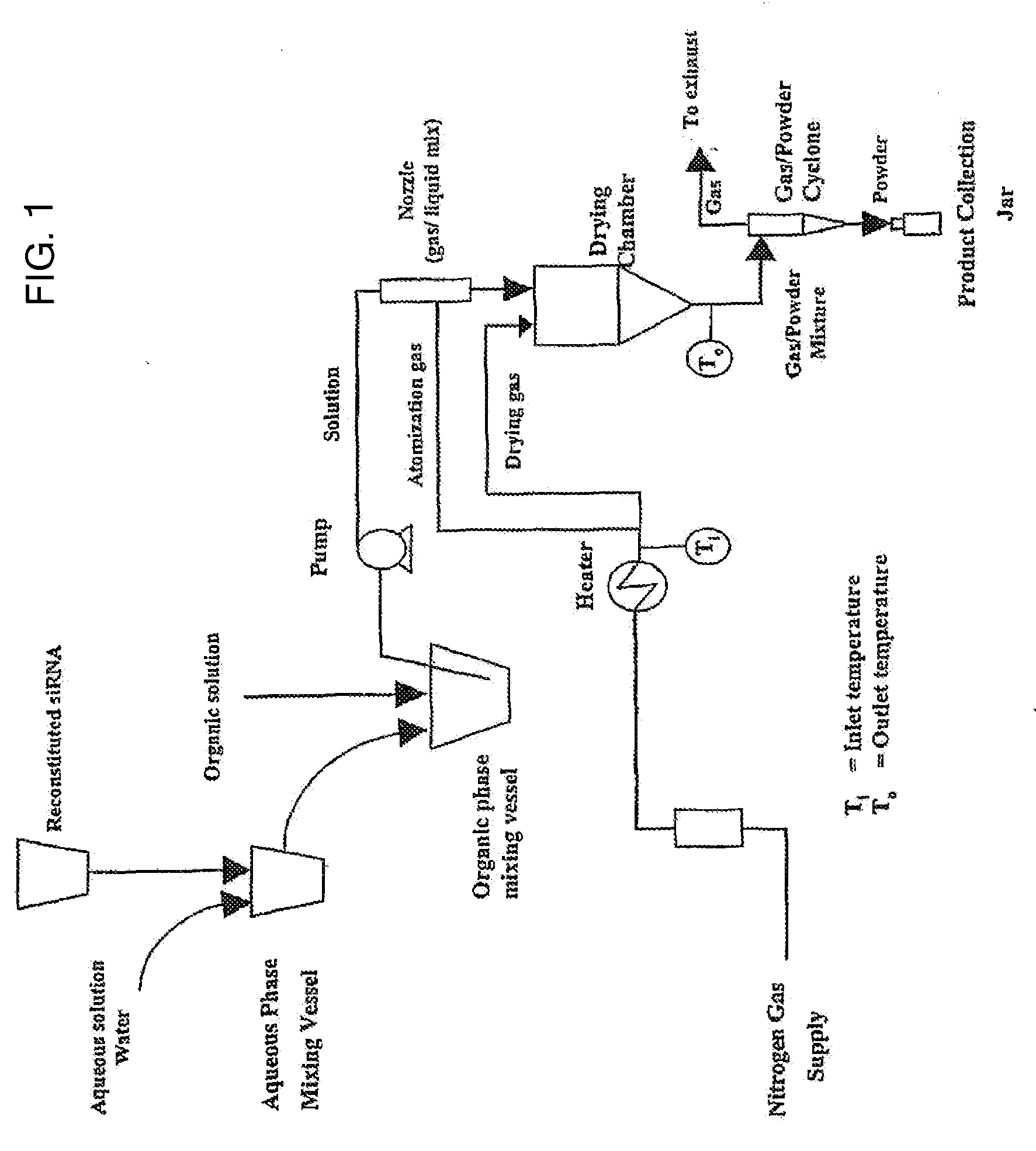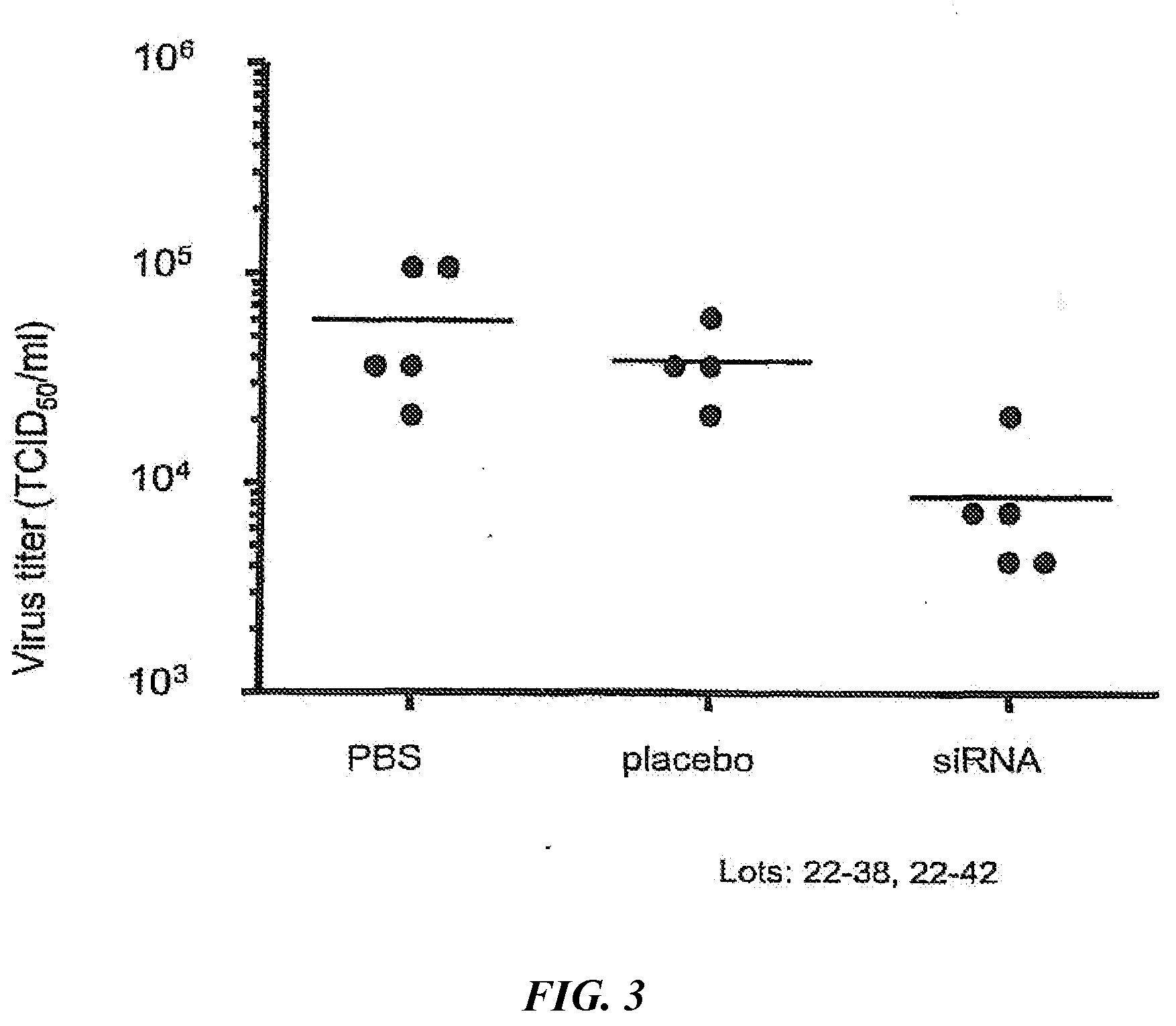Dry powder compositions for RNA influenza therapeutics
a technology of rna and compositions, applied in the field of dry powder compositions for rna influenza therapeutics, can solve the problems of significant risk of serious influenza outbreak, drawbacks in oral and intravenous administration, and inability to introduce sirnas into cells in vivo, so as to enhance the therapeutic effect of the active agent and increase the amount of water in the water emulsion
- Summary
- Abstract
- Description
- Claims
- Application Information
AI Technical Summary
Benefits of technology
Problems solved by technology
Method used
Image
Examples
example 1
Materials
[0165]Ethanol, Denatured, anhydrous (VWR International, West Chester, Pa.).[0166]Sodium citrate (USP, Sigma Aldrich Inc., St. Louis, Mo.).[0167]Calcium chloride dihydrate (Certified ACS, Fisher Scientific Company L.L.C., Fair Lawn, N.J.).[0168]Albumin from bovine serum, minimum 98% (Sigma Aldrich Inc., St. Louis, Mo.).[0169]1,2-Dipalmitoyl-sn-Glycero-3-Phosphocholine (DPPC) (Genzyme Corporation, Cambridge, Mass.).[0170]D-(+)-lactose, monohydrate (ACS Reagent, J T Baker, Phillipsburg, N.J.).[0171]L-Arginine (>99.5% (NT), Fluka A G, Switzerland).[0172]L-Leucine (>99.5% (NT), Fluka A G, Switzerland).[0173]Sucrose (Analytical Reagent, Mallinckrodt Baker, Paris Ky.).[0174]Protamine sulfate from salmon (Grade X, Sigma Aldrich Inc., St. Louis, Mo.).[0175]Influenza: Strain PR8.
example 2
Method for Determining Viral Titer by Hemagglutination Assay
[0176]Viral titering was used to determine the effectiveness of various formulations of the invention for siRNA delivery. Specifically, for prophylactic use, siRNA targeting the influenza virus nucleoprotein mRNA were formulated into dry powder formulations and administered (10 mg / kg siRNA) to Balb / c mice intranasally or intratracheally. Animals were anesthetized with a mixture of ketamine and xylazine. Four hours later, mice were inoculated (intranasally) with 30 PR8 viral influenza particles to initiate infection. Mice were sacrificed at 48 h following infection, and lungs were harvested. Lungs were homogenized, and the homogenate was frozen and thawed twice to release virus.
[0177]The siRNA was G1498.
[0178]PR8 virus present in infected lungs was titered by infection of MDCK cells. Flat-bottom 96-well plates were seeded with 1.8×104 MDCK cells per well, and 24 hrs later the serum-containing medium was removed. 30 μl of lun...
example 3
[0182]In this example (lot 22-23), the dry powder formulation was siRNA, DPPC, sucrose, and albumin (20:40:20:20 by weight). To prepare this example, an aqueous solution containing 150 mg of siRNA, 150 mg of albumin, and 148 mg of sucrose (total volume 75 ml) was mixed with 175 ml of ethanol containing 299 mg of DPPC. Prior to combining the solutions they were mixed with a magnetic stir bar. After the aqueous solution was added to the organic solution the combined solution was mixed by magnetic stir bar, at room temperature for approximately 6 minutes before the solution was spray dried. Conditions for spray drying were Tinlet=95° C., Toutlet=˜55° C., atomization / drying gas flow rate was 600 L / hr.
[0183]As shown in FIG. 2, and summarized in Table 2 (see below, Example 10), this formulation exhibited an average delivery efficiency of 59.64%. This formulation, targeting the NP protein, inhibited viral titers by 83.9% as compared with a formulation that did not contain the virus targeti...
PUM
| Property | Measurement | Unit |
|---|---|---|
| mass median aerodynamic diameter | aaaaa | aaaaa |
| mass median aerodynamic diameter | aaaaa | aaaaa |
| density | aaaaa | aaaaa |
Abstract
Description
Claims
Application Information
 Login to View More
Login to View More - R&D
- Intellectual Property
- Life Sciences
- Materials
- Tech Scout
- Unparalleled Data Quality
- Higher Quality Content
- 60% Fewer Hallucinations
Browse by: Latest US Patents, China's latest patents, Technical Efficacy Thesaurus, Application Domain, Technology Topic, Popular Technical Reports.
© 2025 PatSnap. All rights reserved.Legal|Privacy policy|Modern Slavery Act Transparency Statement|Sitemap|About US| Contact US: help@patsnap.com



